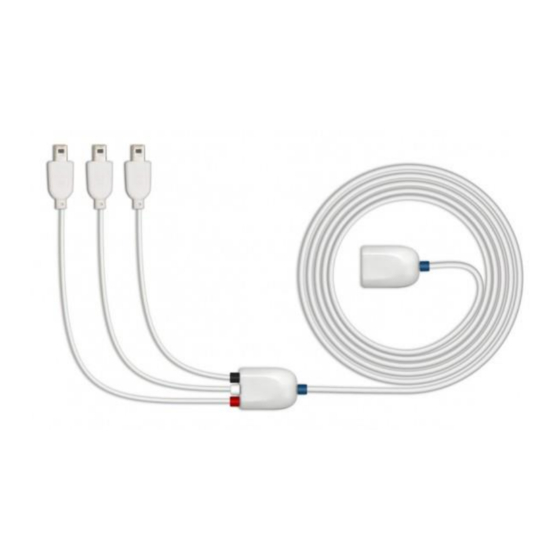
Summary of Contents for biosignalsplux SENSPRO-ACC
- Page 1 biosignal acquisition tool-kit for advanced research applications Accelerometer (ACC) Sensor User Manual...
- Page 2 ATTENTION Please read this datasheet before using your biosignalsplux sensor The information contained in this document has been carefully checked and were made every effort to ensure its quality. PLUX reserves the right to make changes and improvements to this manual and products referenced at any time without notice.
-
Page 3: Table Of Contents
1.6. Transfer Function (Conversion Formula) ................5 1.7. Physical Characteristics ...................... 6 2. Application Notes ........................7 3. Using the Accelerometer (ACC) Sensor with biosignalsplux & OpenSignals ......... 8 3.1. Connecting the sensor to biosignalsplux Systems ..............8 3.1.1. biosignalsplux 4-Channel Hubs ..................... 8 3.1.2. -
Page 4: General Information
Parkinson patients. Figure 1: biosignalsplux ACC sensor (standard version) 1.2. Typical Unfiltered Sensor Output Figure 2 shows a typical unfiltered... -
Page 5: Sensor Specifications
> Robotics & Cybernetics > Biomechanics 1.6. Transfer Function (Conversion Formula) The analog sensor signals acquired with biosignalsplux devices are converted into digital values ranged between 0 and 2 -1 (n=sampling resolution, usually 8-bit or 16-bit) and streamed in the raw digital format. -
Page 6: Physical Characteristics
Accelerometer (ACC) User Manual 1.7. Physical Characteristics > W1 x L1 x H1: 1.6cm x 2.2cm x 0.5cm > W2: 1.0±0.1cm > W3: 1.0±0.1cm > W4: 0.5±0.1cm > L2: 1.3±0.1cm > L3: 0.7±0.1cm > A1: 105.0±0.5cm > A2: 8.5±0.5cm > H2: 0.7±0.1cm >... -
Page 7: Application Notes
Accelerometer (ACC) User Manual 2. Application Notes This sensor requires a calibration to provide reliable measurements. The resulting calibration values (�� & �� ) which are needed for the transfer function below are determined by performing a very ������ ������ slow 360°... -
Page 8: Using The Accelerometer (Acc) Sensor With Biosignalsplux & Opensignals
Accelerometer (ACC) User Manual 3. Using the Accelerometer (ACC) Sensor with biosignalsplux & OpenSignals 3.1. Connecting the sensor to biosignalsplux Systems 3.1.1. biosignalsplux 4-Channel Hubs biosignalsplux ACC sensor is compatible with all 4 analog input channels of the 4-channel biosignalsplux hub, but incompatible with the reference/ground port. -
Page 9: Configuring The Sensor In Opensignals
User Manual 3.2. Configuring the Sensor in OpenSignals 3.2.1. OpenSignals (r)evolution (Windows, macOS, Linux) Note Download OpenSignals (r)evolution here: https://biosignalsplux.com/index.php/software Open the OpenSignals (r)evolution device manager to access and configure your biosignalsplux device. Figure 7: Access the OpenSignals (r)evolution device manager. - Page 10 Activate the channel for acquisition by clicking on the circle next to the channel type (must be blue). If not done before, follow the instruction available in section 3.1 Connecting the sensor to biosignalsplux Systems to learn how to connect your device to your biosignalsplux device.
-
Page 11: Scientific Publications Using The Sens Sensor
User Manual 4. Scientific Publications Using the SENS Sensor The following scientific is only a small selection extracted from the list of available publications using biosignalsplux. Please visit the following website to access the entire up-to-date list: https://biosignalsplux.com/index.php/learn/publications-comm Publications A. Bernardino, C. Vismara, F. Baptista, F. Carnide, S. Oom, S. Bermudez i Badia, E. Gouveia, H. Gamboa, "A Dataset for the Automatic Assessment of Functional Senior Fitness Tests using Kinect and... -
Page 12: Safety & Maintenance
Accelerometer (ACC) User Manual 5. Safety & Maintenance 5.1. Safety Instructions Please read the following safety instructions before using your biosignalsplux system with the sensor to prevent any damages or problems with the user, test persons and/or biosignalsplux devices. Violations of these instructions can lead to inferior signal quality and/or damages to the biosignalsplux system and user. -
Page 13: Transportation And Storage
Accelerometer (ACC) User Manual The user should not immerse the sensors or the biosignalsplux device, nor clean with liquid or abrasives. The user should handle the biosignalsplux device with caution and not expose the device or accessories to high accelerations and vibrations. -
Page 14: Ordering Guides, Regulatory & Legal Information
3rd party system you’re connecting to the device. Check the electrical specifications of both systems you want to connect to prevent any damage of the user(s) or the systems. - Page 15 Accelerometer (ACC) User Manual prevention of disease. We expressly disclaim any liability whatsoever for any direct, indirect, consequential, incidental or special damages, including, without limitation, lost revenues, lost profits, losses resulting from business interruption or loss of data, regardless of the form of action or legal theory under which the liability may be asserted, even if advised of the possibility of such damages.
- Page 16 Accelerometer (ACC) User Manual PLUX Wireless Biosignals S.A. email: plux@plux.info web: http://www.plux.info Headquarters Zona Industrial das Corredouras, Lt. 14 – 1° 2630-369 Arruda dos Vinhos Portugal tel.: +351 263 978 572 fax: +351 263 978 902 Lisbon Office Av. 5 de Outubro, n° 70 – 2° 1050-059 Lisboa Portugal tel.: +351 211 956 542...

Need help?
Do you have a question about the SENSPRO-ACC and is the answer not in the manual?
Questions and answers